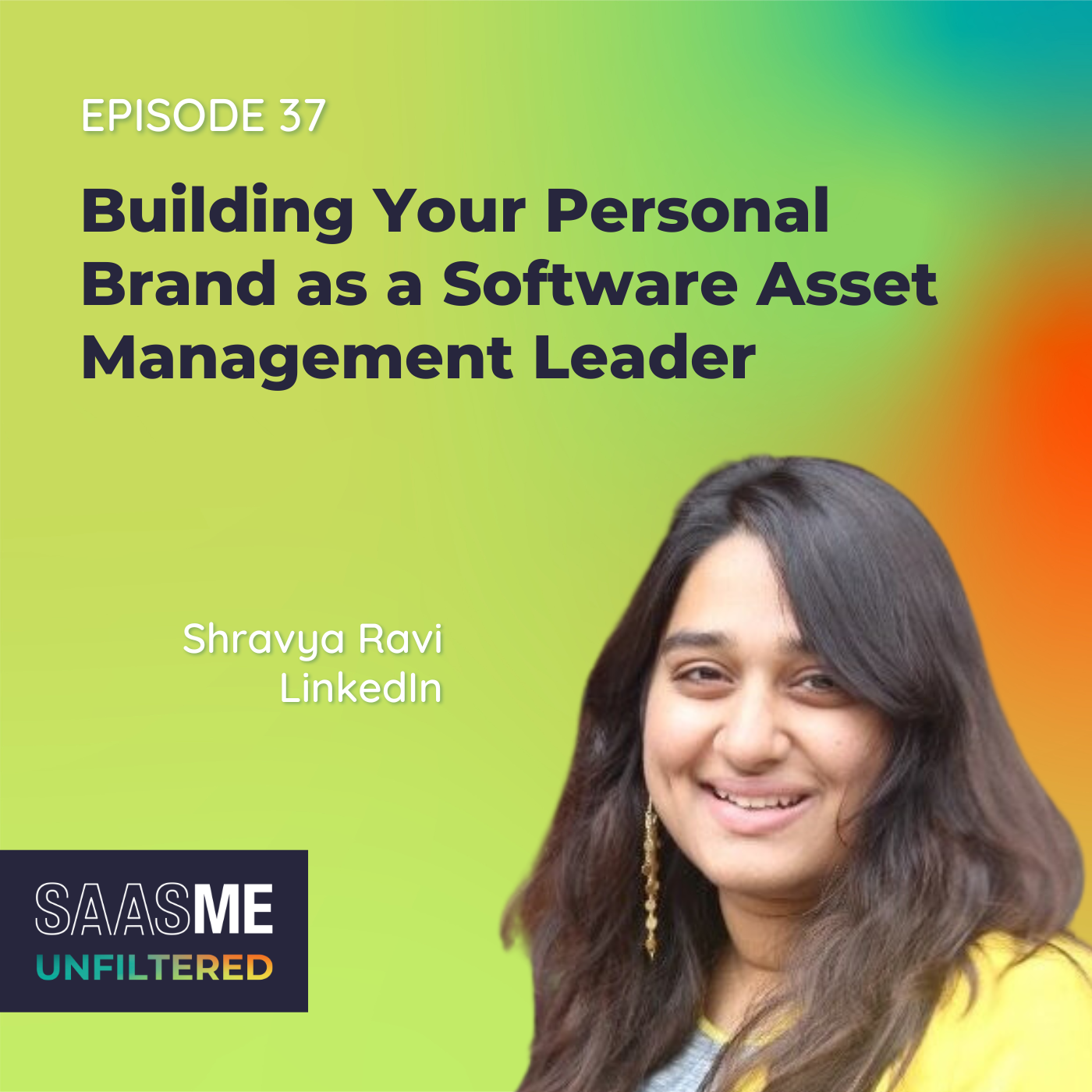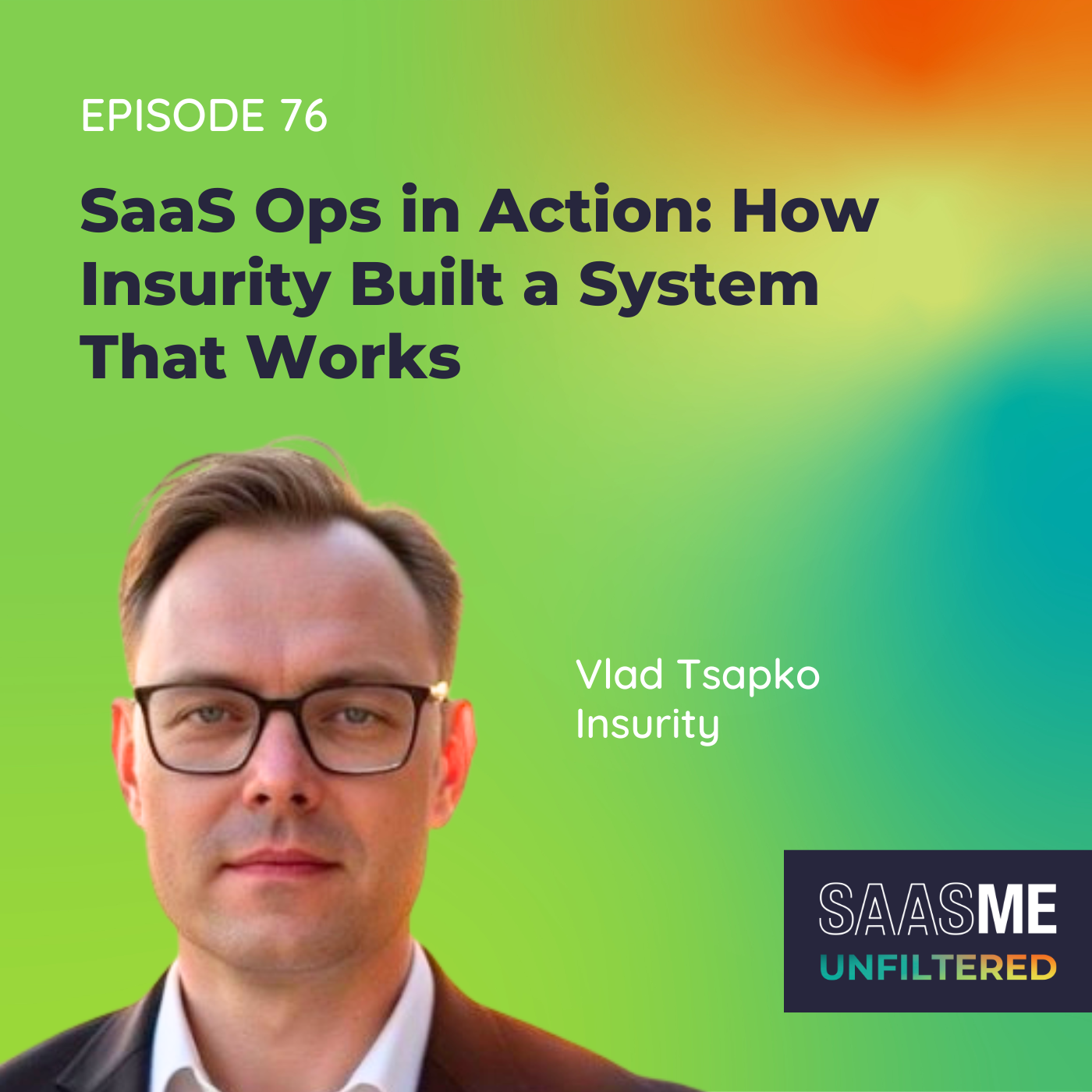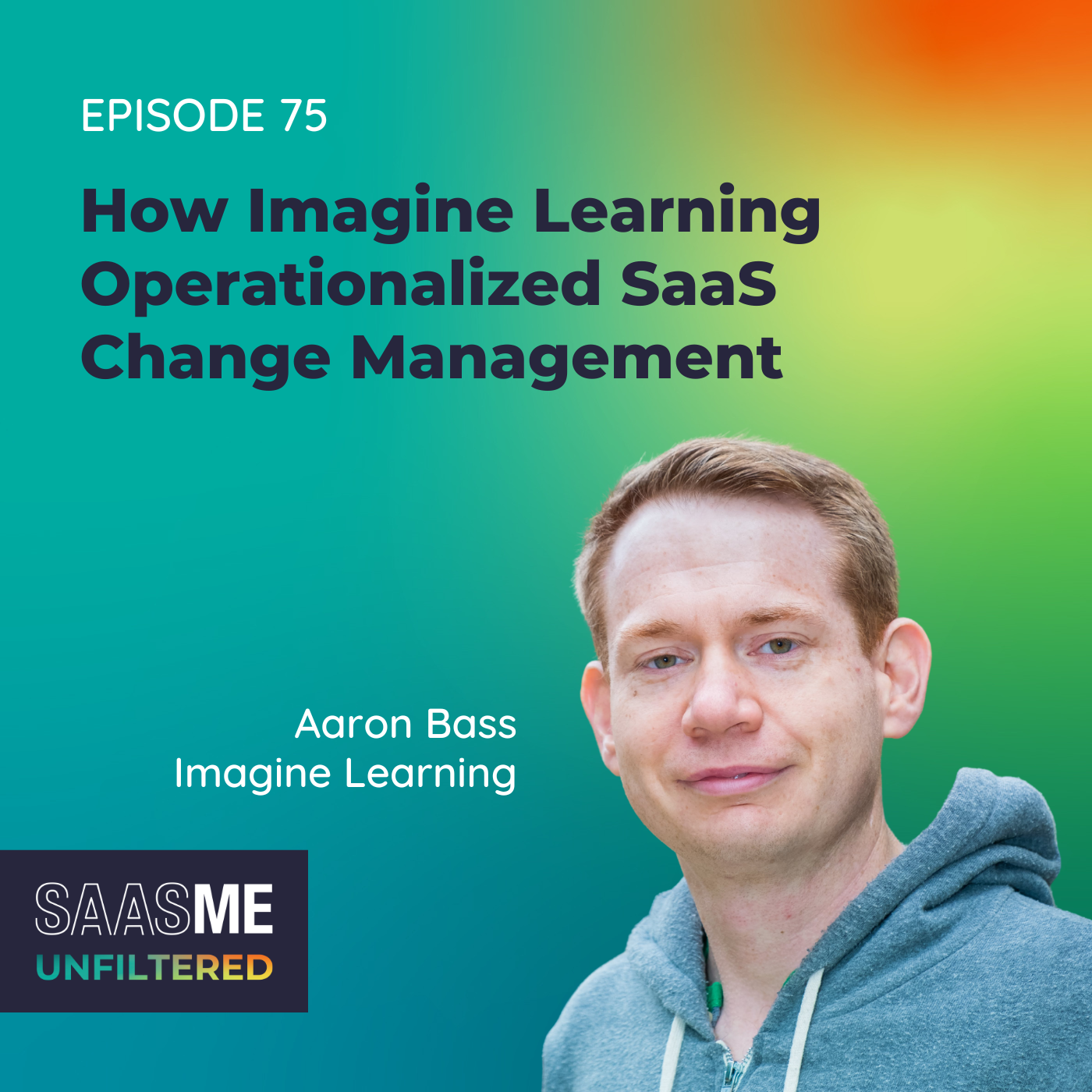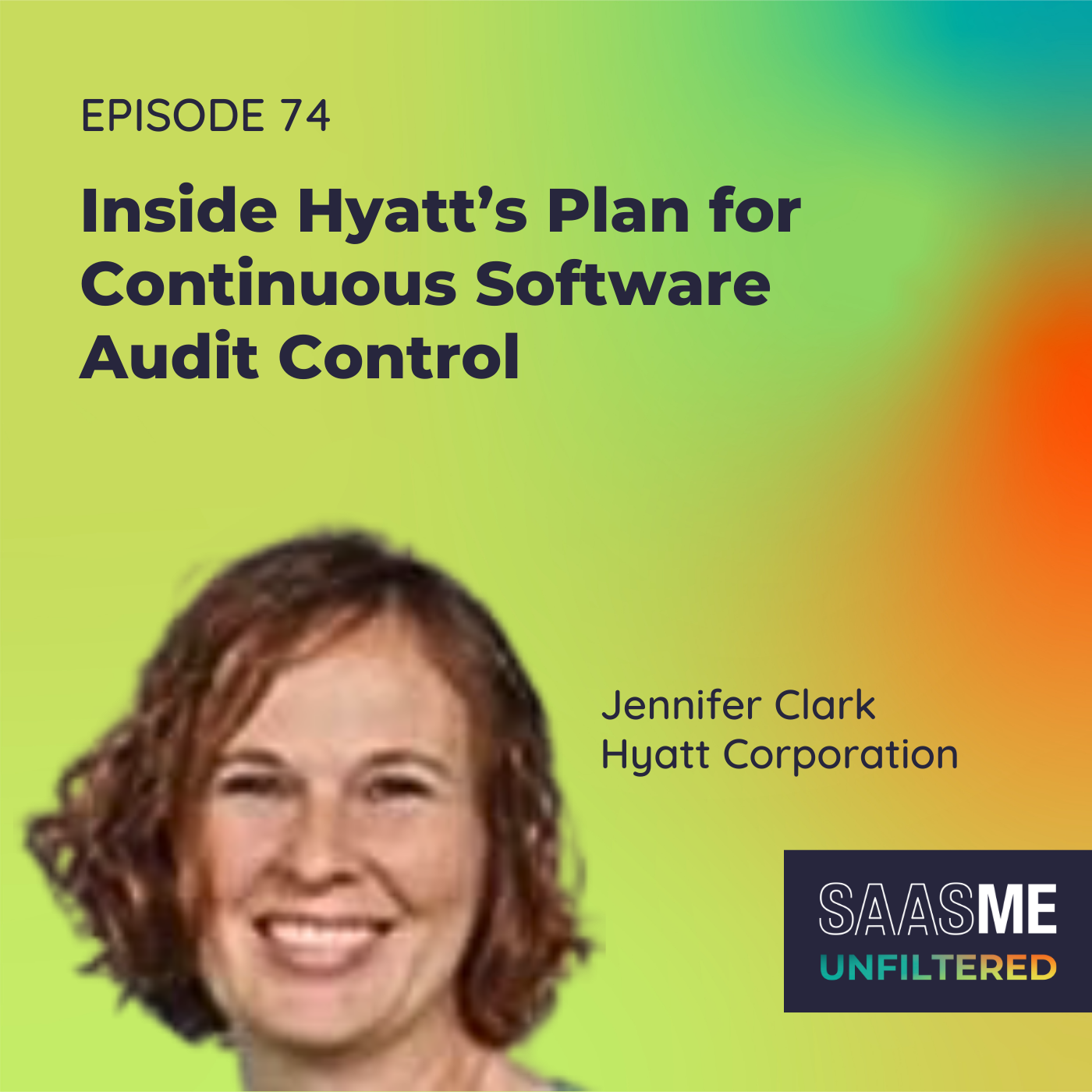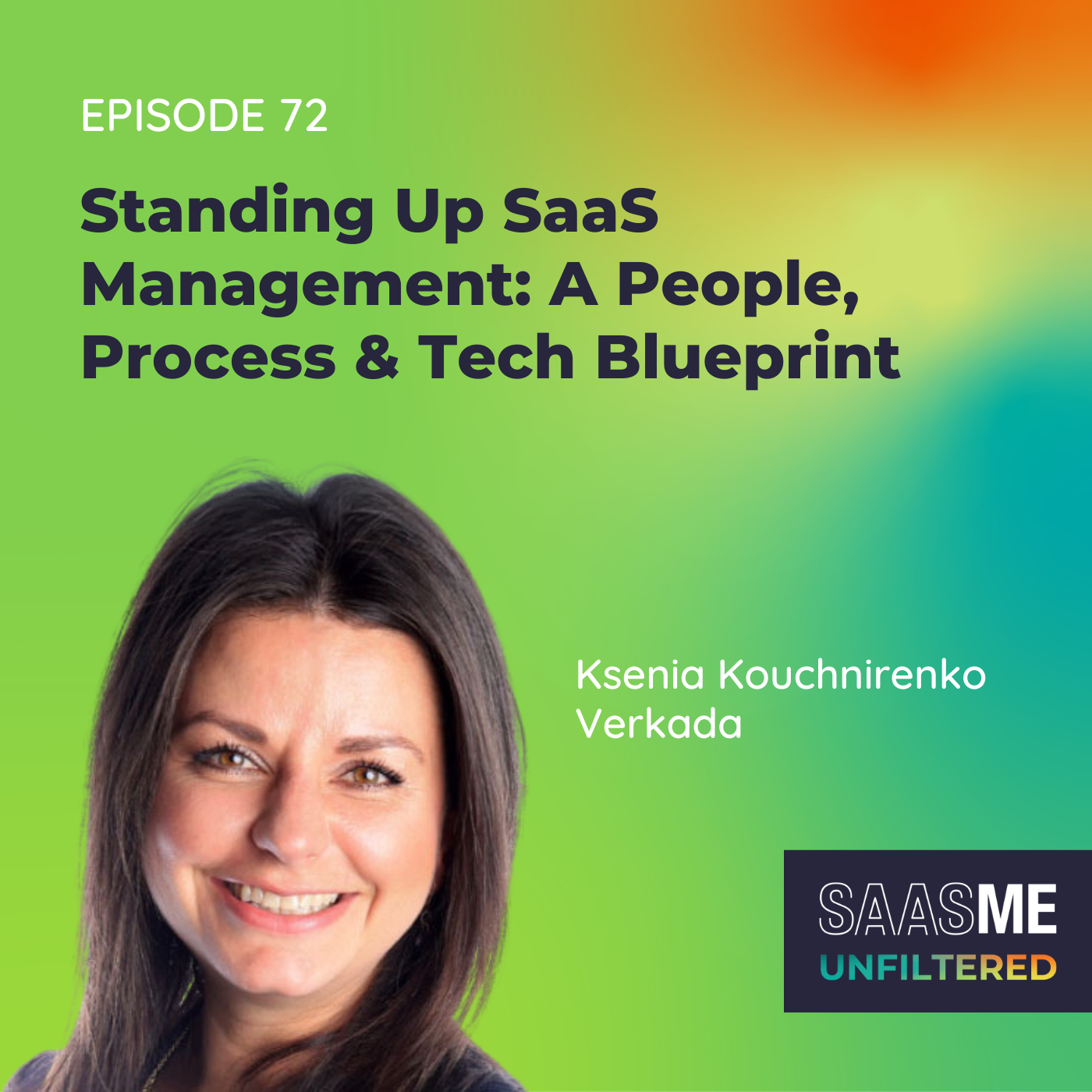Shravya Ravi: Building Your Personal Brand as a Software Asset Management Leader
- 0.5
- 1
- 1.25
- 1.5
- 1.75
- 2
Shravya Ravi: Historically I think software asset managers have been looked at as individual contributors or people that execute, an evolution from that mindset is needed to step into the SaaS world because it's also about volume, right? Before we would deal with 10 different vendors, maybe 20 or 30, now it's like in the hundreds. And how do you communicate this out? How do you build trust in the data, especially when it's coming to a scale like this? So I think that all software asset managers at some point, even if they're individual contributors, will be looked at as leaders.
Cory Wheeler: Hello, hello, and welcome to SaaSMe Unfiltered, the SaaS management podcast. The show with give it to you straight, real- life advice from pros knee- deep in SaaS every single day. SaaS management superheroes just like you. We're back for another episode of SaaSMe Unfiltered. Very excited to have everyone joining us today. I'm Cory Wheeler, co- founder and chief customer officer at Zylo.
Meredith Albertson: And I'm Meredith Albertson, chief marketing officer at Zylo.
Cory Wheeler: Okay, very excited. Lots of excitement today around our next guest. Previously this guest was a senior program manager for ITAM at Cruise and was a SAM manager at Deloitte for about nine years. Today at LinkedIn she leads the software asset management group and a team really, that's responsible for optimizing the IT assets within LinkedIn and delivering value through compliance and efficiency to the organization. She is passionate about leveraging technology and data to drive business outcomes and innovation. On the personal side, she's a mother of a six- year- old, a global communications lead for Families ERG group at LinkedIn, she loves baking and reading, and loves sci- fi, fiction, and fantasy. Welcome to the show, Shravya Ravi. How are you?
Shravya Ravi: Hey, Cory. Hi, Meredith. Thank you for having me. I'm doing good. And that was an amazing introduction. Love it. Thank you.
Cory Wheeler: Well, it's been very fun getting to know you, getting to know your journey. Sometimes for our customers I love understanding, almost as much as the current problems they're solving, where they came from, and what they're bringing into the role, and new perspectives that they're bringing into the role. And your perspective at LinkedIn has been one that we've learned from you just as much as you've learned, as you've gone live with SaaS management. So in today's episode we're going to get your viewpoint on a few areas, software asset management as a strategic partner to the business, we're going to talk about your unique approach to problem solving, and then we're going to ask how you're applying those in your work today. But before we get in, I want to talk about that career journey. So you started in consulting at Deloitte and you're leading SAM internally at LinkedIn. So what set you on this path originally, and what are the experiences or lessons that help shape where you're at today?
Shravya Ravi: Before my career at Deloitte I actually had a computer science degree. A lot of time during me getting that degree I realized that I didn't want to spend my days coding, and I was trying to find something that fit between coding and business. And that led to me getting a master's degree in information systems. That was my first interaction to using my technology background along with the business. And then quickly after I tried multiple things at Deloitte which was great, in consulting, right? You get to be on different types of projects. Done a lot of it, and I did general ledger analysis, to SOX compliance, to financial audits, and then royalty inspections. A lot of it. One of the projects that I ended up doing was a licensed compliance program for a technology vendor, and that kind of kicked off my path forward in terms of, " Oh, hey, here's an audit..." I was the auditor that everyone hated, right? I would be the one sending those letters saying, " We're coming to audit you, be ready." Throughout that experience there were a few instances of going back to the same companies and the companies basically paying a fine every single time we showed up. That kind of led to the evolution of the license compliance program through a software asset management program, and helping clients that basically didn't know how to start their software asset management programs. So over the course of many years at Deloitte I had multiple companies either kickstart their SAM program or come in in the middle, where they were stuck and didn't know where to go after the first round of either implementation or a process. So that kind of brought in a lot of perspective and experience in the software asset management launch.
Meredith Albertson: Well, Shravya, through all that strategic consulting work and those amazing projects that you were a part of, you've developed a really fantastic purview about SaaS and software asset management, and you've seen firsthand all the various changes and successes along the way with all these companies that you worked for. And now you're really applying all that knowledge to building and leading the SAM program at LinkedIn. Now today's SAM professionals, they really have their feet in kind of two different worlds in this on- prem software and cloud software and SaaS. And SaaS really seems to be ushering in this new era for software asset management professionals. What kind of mindset do you believe that SAM leaders need to have as they start to learn and shift their focus from that on- prem that they're so used to working with day in and day out?
Shravya Ravi: When I was working in consulting, a lot of the times the first question I always asked was, " Where's the money?" And we always followed the money. I've seen a shift personally in the type of work and the work that I've done in the last couple of years, where every time I stepped in and did a quick analysis of where the most money is going from a spend perspective, especially in the last three years, there was a significant shift in the amount of money spent, on- premise software towards cloud or subscription- based software. And that's kind of where I started thinking about shifting strategies. Once you follow the money, you see where the biggest opportunities to save are as well, right? So, yeah, I started looking at that moving from on- prem. There's still spend, it's not that it's going away, but from a SaaS perspective, follow the money. Once you have the clarity of what it is that you want to do, once you discover all your SaaS, that's kind of where you start, at least from the SAM perspective. I'm sure there's others.
Cory Wheeler: Oh, yeah, that's good feedback. I want to maybe even back that up just a half- step from there as well. When did you start thinking that SAM was more than on- prem in a very forward- looking, intentional way? Meaning, when did you start thinking, and maybe it was the move into LinkedIn that's got lots of SaaS in their environment comparatively to other organizations, but when did you start thinking SAM is now multifaceted around software to manage both on- prem and SaaS?
Shravya Ravi: For me the eye- opening moment actually kicked off with this one project that I got on in consulting where I was used to a certain type of environment. Every time I went I had a framework in mind on, okay, let me find this, let me do that. Let me find the active directory and LDAP, install software, that sort of a thing. And then I ended up on a client that basically had none of what I knew, like literally nothing. They had SSO, they had Okta, they had a lot of open- source... Only Linux, nothing else. So that was like a complete game changer for me. And when I looked at how was it that this company is different and how do we approach the problem solving for this specific company, I didn't realize at that time, but that was kind of the pivotal moment when I started learning new technologies on what else is out there and not necessarily what we know of. I would say that was kind of where the SaaS management journey kick- started. From there onwards, weirdly every other company that I've worked on, either outside of consulting or within consulting, I started to see or notice more of the same, right? Kind of like when you're pregnant. You only see pregnant people all around. So that's kind of where it kick- started, but then after that I spent time educating myself in what else is going on and what else is going to influence the future of SAM.
Meredith Albertson: Well, Shravya, for SAM professionals, on- prem is not going away. SaaS is here, SaaS is here to stay, but there is a bit of a learning curve when it comes to managing SaaS cloud software. I imagine you have seen a ton of things that have worked and have not worked. What are some of the biggest missteps that you have seen SAM leaders and SAM professionals making when it comes to SaaS, and are there ways that they can actually turn those challenges into opportunities?
Shravya Ravi: I'll use my personal experience and then also tie in what I've observed so far. The first thing with SaaS, the biggest difference I have noticed with SaaS and your on- prem is the discovery. I want to start with the discovery because finding SaaS is not easy. It's a difficult, complicated, has money, and many, many layers on how we're going to find what someone is using within the company. Outside of tracking people's browsers' histories, which I'm sure Privacy will frown upon, there's not really a good way, a standardized way to find something that's being used in your environment. So I think that a visibility portion is really important. If you think that you know everything just by looking at spend, you're probably wrong. There's other places you're going to find SaaS being used that we're not aware of. So assuming and running a SAM program or a SaaS management program thinking that you know everything would be the first mistake. It's going to be a continuous discovery. It's going to have to be an ongoing process. The second part of it is customizing your solutions to the company's, or the organization that you work for, their strategic goals and the culture, right? When I first started at some of the companies that I worked for, I always went in with I'm going to save money, and that's not always worked out, right? Because some companies have the culture of, " I'm going to give everything my employees need for them to be productive. It's not about money, it's about making sure they have everything they need to do their job," right? Or some companies have the approach of, " Hey, let's invest in the right tools. Let's meet about 80% of the use cases, the rest of the 20 we'll deal with as they come across." It really depends. So really tailoring your approach for SaaS management to the company that you are designing this program for, and their values, their vision, their goals, and their strategic objectives, is going to be really important. One last area I want to touch on that gets ignored quite a bit is education. I feel like educating end users on SaaS is not really a component that all programs look at. But when you really think about the difference between historically on- prem where only admins and certain type of users had control on what they would bring into the environment, how they would install it, versus right now end users installing, or buying, or using third parties via a browser, it's just become so much more easier to sign up for a service or software. So educating end users on the risks on how it is that they need to think about when they're using software outside of whatever's available within their company's catalog, or something like that, is going to be really important.
Cory Wheeler: Yeah, what great insight. Education and the ability to work internally. And as you think about your journey from on- prem SAM to SaaS SAM management all falling under the SAM umbrella, 10 years ago, IT teams owned software. They owned it, they provisioned it, they managed it, they hosted it, really everything rolled into IT. And today, it's a very distributed world, where everybody has an application, they love it, they don't want to get rid of it. So what are the skill sets now for this new world? When you're hiring at LinkedIn, when you're thinking about that next innovative challenge, what skill sets are important for a SaaS- minded SAM leader to have, to be successful?
Shravya Ravi: There's a couple of things that come to mind and I don't think this is just LinkedIn or any company, right? As an individual to develop as a professional, you strive to become an expert in the core set of skills, which is basically could be data analytics, could be understanding contracts really well, could be delivering actual deliverables. It could be a report, or it could be a presentation. All of these are skills that everyone should be really good at, and then you build on top of that. So you trust that people that want to become SaaS management professionals or SAM professionals already have these base skills. And then on top of that what really sets you apart is how you're going to use insight coming out of these skills in presenting them to the right person or personas, and changing your delivery depending on who you're talking to. What does the other person want, how are you matching what it is that they're looking for, and customizing and adapting is what's going to be one of the differentiating factors when you come across these people.
Cory Wheeler: Yeah, well put, well put.
Meredith Albertson: And working with you and your team, we have just noticed over here at Zylo that you're just such a strategic voice at the table, and you're a key player in making your software and your SaaS management program successful. How do you think about growing your personal brand within a company culture and building that level of trust within an organization? Is there some advice that you would give to other SAM leaders that are aspiring to build programs and build that same trust within their own organizations?
Shravya Ravi: Historically I think software asset managers have been looked at as individual contributors or people that execute, an evolution from that mindset is needed to step into the SaaS world because it's also about volume, right? Before we would deal with 10 different vendors, maybe 20 or 30, now it's like in the hundreds. And how do you communicate this out? How do you build trust in the data, especially when it's coming to a scale like this? So I think that all software asset managers at some point, even if they're individual contributors, will be looked at as leaders that are going to influence strategy. And for my personal advice, for anyone that's looking to move into that path or are already in that path, is one, you have to create your own opportunities, or find other projects, or projects within your organization that you can influence with whatever you know about your SaaS stack. Using these opportunities that you either made for yourself or found through other projects, you should use that opportunity to show your skills, show your knowledge, the base skills that we were talking about, the analysis and all of that, leveraging that and showing it in these platforms. I think that would be step one. And then my personal favorite is creating content and the education. I love creating decks. It's probably coming from my consulting background too. I love doing that. I love putting in front of people, " Hey, this is what our team does, this is how we're going to help you, and this is how you could potentially take this deck and use it for your own teams or your own roadmaps." So, yeah, circulate your knowledge, teach other people what you know, and you're doing that over time with consistency, with authenticity and a drive to share your knowledge, that's you building your brand throughout your organization. I have a favorite quote, it goes, " Execute with precision and lead with a vision." I think a delicate balance between those both is where you want to be.
Meredith Albertson: If you're not unlocking the full value of your SaaS, what are you doing? There is no denying it. SaaS is mission- critical to your company's growth and success. And as the number two operating expense for most organizations, it's your biggest opportunity to save money and drive efficiency. The time is now to do something about it. Join me and your fellow IT, SAM, finance, and procurement leaders at SaaSMe. SaasMe is the industry's only dedicated SaaS management event where you can sharpen your skills, hear from your peers, and learn how to unlock value and responsible business growth through smarter SaaS management. Register today at sassme. com. That's S- A-A- S- M- E. com. It sounds like building those decks and sharing that story is a great way to evangelize that work and the wins across your organization in a really easy way.
Cory Wheeler: I also think the way that you articulated it just sounds like a wonderful leader as well.
Meredith Albertson: Well, thank you.
Cory Wheeler: So take that for what it's worth.
Shravya Ravi: I will take it and frame it. Oh, go ahead.
Cory Wheeler: You should take that and frame it, there you go. Well, I want to dive into the specifics now, the diagnostics behind SaaS management, how you've wrangled this problem, how you assess this problem internally, and started an approach around it, really pioneering this for your organization. So one thing that I've noticed as we've worked together is that, that diagnostic approach, it really comes down to problem solving within SaaS. What I mean by that is you don't make very quick decisions to address a one- off pain point. You look at the data, you sit back, you ask thoughtful questions, you think ahead, you look around corners, and get to the root of the problem in order to solve the problem. So one of the hardest things to do as a leader is to be that deep in the weeds with all of the data, all of the integrations, all of the insights, and then be able to take a step back and look at the big picture, and make a strategic programmatic type of decision. You've done this really well. You're impacting the business being a strategic partner while having that level of detail. So how do you convey strategy to leadership while also driving execution within your own team?
Shravya Ravi: I'll repeat the same thing. It might be a repetition, but I'm going to go back to the base skills that I was talking about, right? Once you have those base skills and actually build on, " Hey, what is my company culture? What are my leaders looking for? What do they have as an expectation from my team?" And it really depends on your leader. It depends on your company culture. When you tie all of those and think about what can I do with my base skills, and build on that base data and what do my leaders want to see, and tie that entire thing into your company's strategic goals, I think that's always been my strategy in dealing with uncertainty. Not knowing, hey, where is this program going to go, how am I going to make use of all of this information that I have in my hands, but also put it in a way that conveys the scale and the intensity of the problem that's at hand.
Meredith Albertson: We talk about this quite a bit on the show, and even I feel like every day here at Zylo, but SaaS is becoming very distributed across the business. Everyone is buying SaaS, everyone is using SaaS. And when you're building this program there's a lot of change management that comes with it. And that's really hard for people, quite a lot to... How do they get their hands wrapped around this, how do they get the entire organization involved. And a lot of that comes from executive leadership, and really needs to be able to bring that throughout the business. What kind of support do you feel like SAM professionals, or you personally, really need to help drive these programs to be successful?
Shravya Ravi: It's something we discuss every day within our team as well. You're lucky if you already have an executive sponsor and a champion that really believes in the true value that SAM or SaaS management can bring to the table. So I would always start with finding executive sponsorship, a champion, that is able to bring alignment at the highest levels in the company, on the importance of SAM and making sure it's run, it's funded, it's kept accountable. So if you really think about how many functions and teams touch software, from planning procurement to the end of a software lifecycle, there is no way that even just a SAM team or a SaaS management program can be the one that brings the alignment. It's always going to be an executive sponsor. So that's always the first step. So from finding someone to do that for you, if it's challenging to find that within your own functional leader, some of the ways that you could potentially think about doing this is going through and seeing what all areas software touches. It could be security, it could be finance, it could be your IAM teams. There is so many functions and teams that actually have a huge impact on SaaS management, and any one of those functional leaders could also be your champion. And all it needs is like one leader saying the right thing in the right forum for you to get that visibility.
Cory Wheeler: So that's a great perspective, now let's shift into execution at the same time. And that's what you're doing every single day. So enterprises, large enterprises like LinkedIn, today have huge tech stacks. Our data shows that most enterprises have over 600 applications and almost a quarter of a million dollars in annual spend according to our SaaS management index data. So for such a large portfolio you've got to have visibility and you can't be implementing a granular strategy that requires a lot of workload and the inspection of every single application. So how do you prioritize? Walk us through that process. Are you following the money? Are you following utilization? Are you following security risks? Or are you executing a healthy balance of all of those to prioritize where to attack first?
Shravya Ravi: I mean, obviously creating the visibility is the first step, right? Because without that visibility you really don't know what you're getting into. Do I even have a strategy for prioritization? So once you do have that visibility, what I found is that, again, with SaaS management, you could be the person that's reporting all of this and working with partner teams to remediate or drive outcomes, or you could be the one driving the outcome. It really depends, again, going back to your organization and what's expected of all of you. From my perspective, once the visibility is there, I usually work with the partner teams on even finding what to prioritize, and making sure our partners and inaudible are on the same board when it comes to prioritization. You've discovered applications coming in that are not behind SSO work, with your IAM team, identity management team, to prioritize which ones need to go behind SSO, ASAP. If you find expense applications against policy, work with your policy team and security team together on prioritizing what's more important. You find under utilization, coming out of the box from your SAM tools or whatever else it is, you already have the data, go after it. You don't have to wait for anything else. Work with partners, work with executives, and obviously make sure that your data is trustworthy at the end of the day. I think all of these together will create a roadmap and prioritization by itself.
Meredith Albertson: I love that perspective. And talking to you, Shravya, this has been just such a great conversation about the strategic role of SAM professionals, but also really with your leadership perspective. And I know we've touched a little bit on it, but we're just big fans over here of just your wonderful methodical approach to problem solving. And I'd like to talk a little bit more about that approach and how it's helping you to drive portfolio strategy. There's obviously a lot of SaaS sprawl that companies are facing, shadow IT, you've got app redundancy and overlap, and purchasing is happening all over the place. Through your approach and your lens, how are you managing the sprawl of applications, and how are you looking at, we talked a little bit about everybody's a SaaS buyer, how are you answering those questions like do we need to bring in another application at this time.
Shravya Ravi: There's so many facets to this-
Meredith Albertson: Big question.
Shravya Ravi: ...question that you... As there's so many solutions too, but I'll go with what I know from my experience. I can't believe how many times I'm tying this back to company culture today. Same thing, same question. What does your organization need and want, and what has been your organization's culture when it comes to SaaS. And do you actually want to change it, right? Because there's the acceptance of, hey, this is my company culture, let me drive a strategy to support it. Or hey, every leader I've spoken to is not supportive of this culture. Let's try and change it. So you either take one or the other approach. But at the end of the day, from a tactical perspective, if I think about what it is that we want to do to evaluate all these applications being brought into our environment outside of the company culture on, hey, let me give everyone what they're asking for versus like doing a deep evaluation of if it's a right fit or not. An evaluation framework is a must in your procurement process on do you want to build versus or buy. Do you have overlapping tools that will do the exact same functionality. Are we creating visibility for the employees to know this is exactly what we have in the company's ecosystem, you are equipped to do what you need to do by looking at our catalog or whatever that visibility stack is, here's that preferred application, and all of that. Outside of that, there's always going to be a layer of financial approval, right? There's always going to be, hey, are you bringing a million dollar thing into the environment without the right research or without like actually doing that analysis of is there another tool that would meet your needs. So a lot of these, but if I had to summarize it in one sentence, it has to be a framework that covers technology, finance, risk, and business together.
Meredith Albertson: Well, Shravya, thank you for sharing that framework. I think there's a lot of incredible and valuable information there for others to start thinking about how do I apply this to my business today. I want to talk a little bit about app consolidation. Consolidation, it's hard, and it's a very sensitive subject at a lot of companies. And you've talked a lot about culture and mindsets today, and I think that there's a lot of this involved most likely with consolidation. But there's a lot of change management, and culture shifts, and mindset shifts that have to take place. What steps are you and your team taking to help really drive this change management?
Shravya Ravi: Outside of the executive sponsorship that we've spoken about, a lot of user education playing along the way, we've been working on so many communication plans in setting these expectations from not just end users, but also application owners, right? There's entire projects and pilots we've kicked off this year to understand, hey, what works, what's not working, and what do we do like for every type of consolidation we're talking about it. It could be consolidation of tools, it could be consolidation of instances or contracts of the same tool. There's so much of those opportunities going on. I think the key for me is pilot, pilot, pilot, see what's working, see what's not working, and then create, again, a framework out of it. This is how we can make it a repeatable process, this is the process that we're going to follow going forward, and then just move forward, right? Got to learn from your mistakes and celebrate the wins.
Meredith Albertson: I love that. Testing, piloting programs. A lot of SAM leaders are facing this pushback. Is that an easy step? Do you think that they could implement in their organizations as setting up sort of a testing or a pilot program themselves?
Shravya Ravi: Again, for SaaS management, I don't think it can be a one- man show, or a one- woman show, or a one person show. We have to partner. And this is what I think has worked well for us. Even with anything that we're piloting we always get partner buy- in. Where are you piloting some remediation of expense applications? Got to partner with your security, and communications, and employee comms teams, and your expense teams, and all of those teams. But my advice is that we have to be very flexible, we can't go in with the approach of I'm going to do this and that not happen. Be flexible, adapt quickly, change your process, or change your approach to solving a solution if you're finding that something's not working. Pivoting, and then also understanding what new lens you can put on to address this problem can also really help. Sometimes it's very easy to fall into our day- to- day and think about it just from a SaaS management or just from a SAM perspective. But the minute you put on someone else's shoes, you'll know exactly their pain in solving these problem.
Cory Wheeler: That's it.
Meredith Albertson: Yeah. Sometimes it's just so important to take that step back.
Cory Wheeler: So we've outlined the big opportunity, the skills you need, the outcomes you're looking for around SaaS management, and really the larger SAM strategies. I have a memory of a few years ago, I was speaking on a panel with SAM leaders and Gartner had just decommissioned or done away with the Magic Quadrant around SAM tools. And it was all the discussion that what's Gartner really thinking about and this is as SaaS management is starting to rise up. Now SAM is evolving into something much, much different than it was 10, 20 years ago. So where do you think SAM is headed next as an industry and as a practice?
Shravya Ravi: Just given how many changes the software industry, not software asset management, but actually software industry has gone through in the last couple of years, at the risk of sounding like someone using buzzwords, it's all in SaaS, it's in artificial intelligence, your containerization platforms if you're thinking about your on- prem and server side of the house, cloud spend, machine learning, all of these I feel like are going to influence the future of SAM. Either from a risk perspective, or a spend perspective, or using these technologies to further SAM perspective. Or it could be a combination of all three. But I have a feeling what we're talking about now in three or four years will be a more mature way of approaching, you leveraging all these technologies.
Cory Wheeler: You said it. That's great. Well, let's close it out with a little bit of a fun rapid- fire segment. I'll ask you, and Meredith will ask you, a couple questions. Would love just your quick-
Shravya Ravi: Mm- hmm.
Cory Wheeler: ...response, and feel free to have a little fun with it, okay?
Shravya Ravi: All right.
Cory Wheeler: All right. Give me three words that you would use to describe your approach to managing SaaS.
Shravya Ravi: Spend, risk, and visibility.
Meredith Albertson: Oh, good ones. Well, I'm going to go on the book side because I know you're an avid reader. I want to know your favorite book that you've read so far this year.
Shravya Ravi: It's called The Priory of the Orange Tree by Samantha Shannon. It's this really good book for someone... If you like Game of Thrones, and Dragons and Magic, ah, lovely.
Cory Wheeler: All right. Adding that to the queue in Amazon. This is the question I've been waiting to ask the entire segment. What's your favorite item to bake?
Shravya Ravi: I love to eat everything that's baked, but I love making tres leches cakes and making variations of them. I just add different flavors and then just pour these, it's a...
Cory Wheeler: That's something I've never made. I like to fancy myself sometimes being a cook or a chef and I've never done that, so great one.
Meredith Albertson: Well, you both have just made me very hungry. All right. The future of software asset management in one word.
Shravya Ravi: Transformation.
Meredith Albertson: Oh, I like that. Well, Shravya, it has been incredible to have you on the show today to learn more about your career journey, the program that you're building, and the business impact that you and your team are having on the business. And there's so many SAM professionals that listen to the podcast, check out the shows that are tackling these same initiatives and these challenges, and your insight, your advice, was incredible and absolutely invaluable. And we just thank you so much for sharing your wisdom and perspective with us today.
Shravya Ravi: Thank you so much for having me.
Cory Wheeler: Thanks, Shravya. Did you enjoy the episode? Pass it along to your friends, subscribe to get notifications for the latest episode, share your favorite takeaways, and join the conversation on social media using# SaaSMeUnfiltered.
DESCRIPTION
“Execute with precision and lead with a vision” is the mantra Shravya Ravi lives and breathes as a software asset management leader. From supporting software management strategies as a consultant at Deloitte to leading an innovative SaaS management program today at LinkedIn, Shravya is a powerhouse. In this episode, she shares the secrets to building your personal brand as a SAM leader – no matter your rank in the organization – and driving significant change and business results.
Key Takeaways:
- [00:00 - 02:08] Introduction to Shravya Ravi
- [02:20 - 05:01] How Shravya's background in consulting at Deloitte shaped her career path to leading SAM at LinkedIn
- [05:01 - 06:55] The mindset SAM leaders need for the job going forward
- [06:59 - 08:50] When Shravya realized SAM was multifaceted and more than on-prem
- [08:51 - 12:08] Missteps in SaaS operations, no standardized way of running a SaaS program
- [12:13 - 13:57] What skillsets are important for SaaS-minded SAM leaders considering innovative futures?
- [13:59 - 16:43] Growing a personal brand within a company culture and inspiring trust
- [18:01 - 19:58] Conveying strategy to partners and leadership: base skills, company culture, and expectations around outcomes
- [19:58 - 22:06] Creating successful SaaS programs and enabling executive and functional leader sponsorship
- [22:08 - 24:26] Prioritizing visibility in SaaS management, finding under-utilization and saving spend
- [27:18 - 28:44] Education plans and steps taken to drive change management and app consolidation
- [28:44 - 30:05] SaaS management can't be a one-person show, advice for testing pilot programs
- [30:06 - 31:33] Where SAM is headed next as an industry and a practice
- [31:35 - 33:18] Rapid Fire & Closing
Today's Host

Ben Pippenger
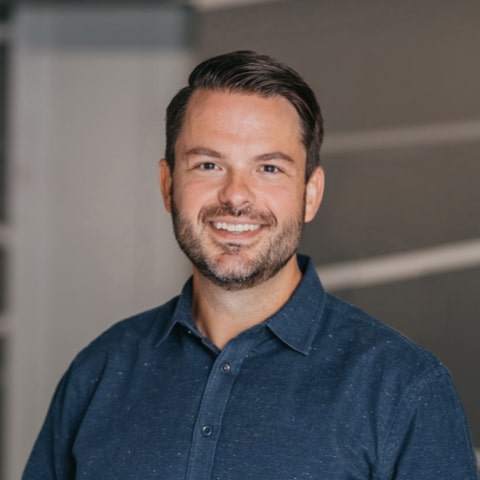
Cory Wheeler
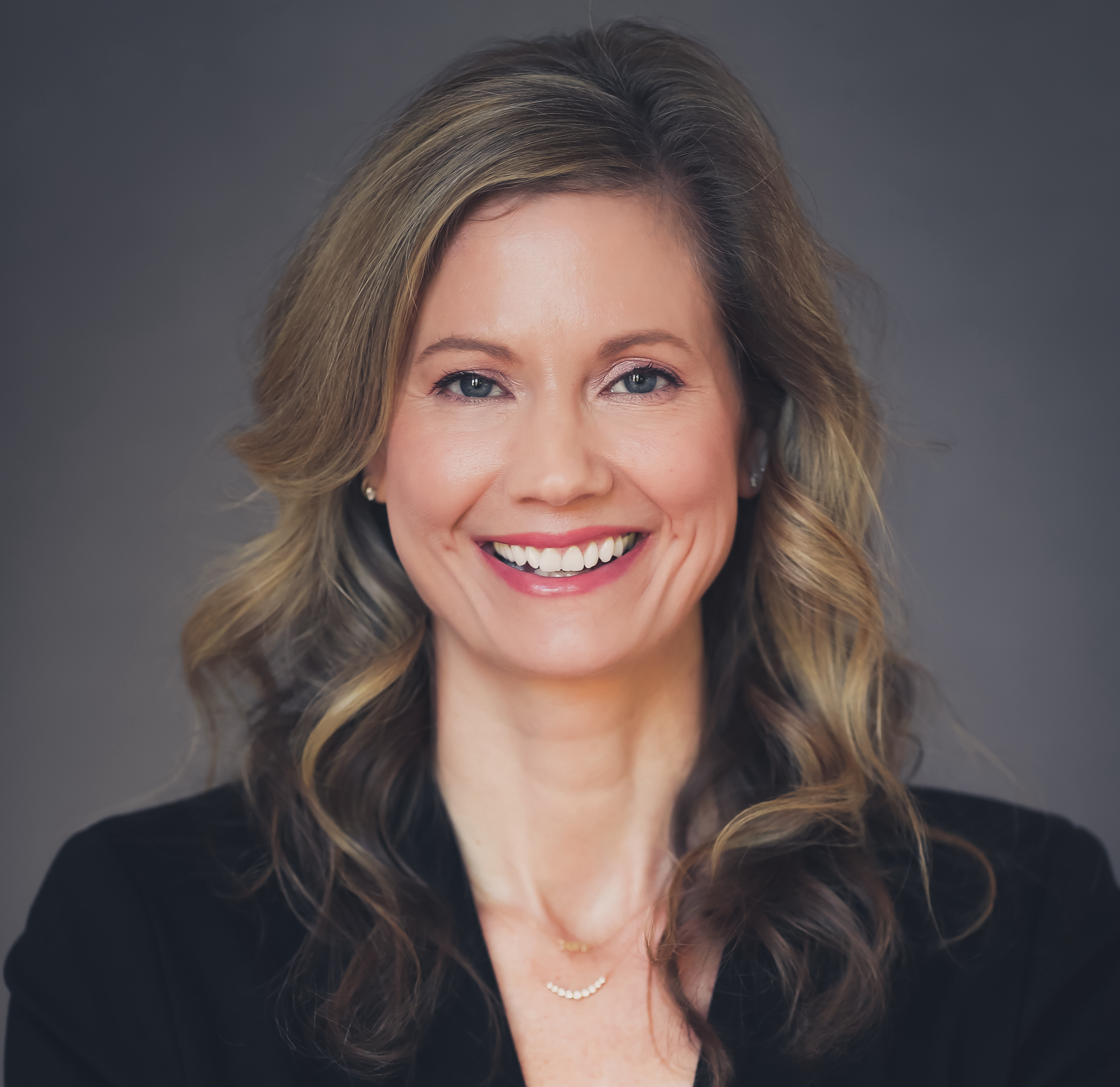
Meredith Albertson
Today's Guests


